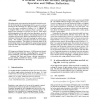Free Online Productivity Tools
i2Speak
i2Symbol
i2OCR
iTex2Img
iWeb2Print
iWeb2Shot
i2Type
iPdf2Split
iPdf2Merge
i2Bopomofo
i2Arabic
i2Style
i2Image
i2PDF
iLatex2Rtf
Sci2ools
SIGGRAPH
1989
ACM
1989
ACM
A general two-pass method integrating specular and diffuse reflection
We analyse some recent approaches to the global illumination problem by introducing the corresponding reflection operators, and we demonstrate the advantages of a two-pass method. A generalization of the system introduced by Wallace et al. at Siggraph '87 to integrate diffuse as well as specular effects is presented. It is based on the calculation of extended form-factors, which allows arbitrary geometries to be used in the scene description, as well as refraction effects. We also present a new sampling method for the calculation of form-factors, which is an Mternative to the hemi-cube technique introduced by Cohen and Greenberg for radiosity calculations. This method is particularly well suited to the extended form-factors calculation. The problem of interactive display of the picture being created is also addressed by using hardware-assisted projections and image composition to recreate a complete specular view of the scene.
Computer Graphics | Corresponding Reflection Operators | Extended Form-factors | Global Illumination Problem | SIGGRAPH 1989 |
| Added | 11 Aug 2010 |
| Updated | 11 Aug 2010 |
| Type | Conference |
| Year | 1989 |
| Where | SIGGRAPH |
| Authors | François X. Sillion, Claude Puech |
Comments (0)

